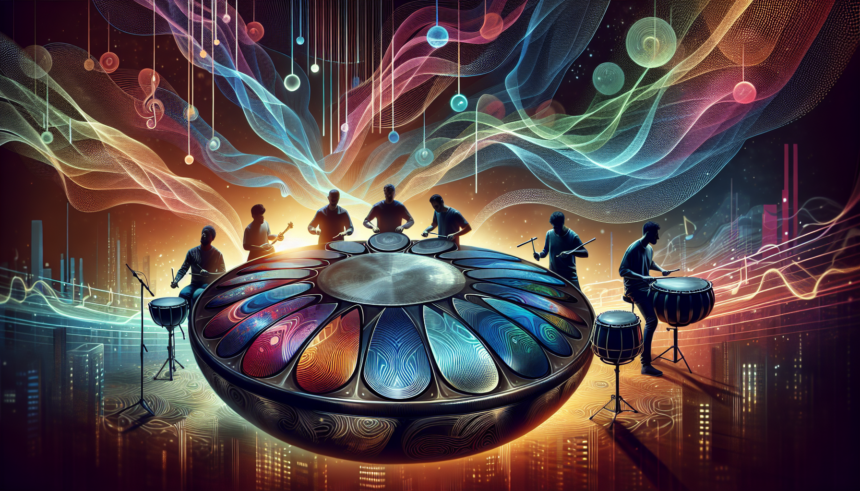The handpan, an ethereal-sounding steel instrument often likened to an alien spaceship in appearance, has gained immense popularity worldwide. Originating in the early 2000s, the handpan’s unique sound and aesthetic appeal have sparked a wave of cultural blending, resulting in a multitude of percussive styles influenced by diverse musical traditions. This article explores the rich tapestry of cultural influences that shape the playing techniques and rhythmic patterns of the handpan, underscoring the universal appeal and adaptability of this relatively new instrument.
The Origins of the Handpan
The handpan was first developed by Felix Rohner and Sabina Schärer in Switzerland under the brand name PANArt Hang. The design was inspired by the Trinidadian steel drums and the Indian ghatam, a traditional clay pot drum. This blend of influences gave rise to an instrument capable of producing a melodious and resonant sound with the simplicity of tapping its surface. While originally born from a European context, the handpan has since evolved, embracing stylistic variations from around the globe.
African Rhythms and Techniques
One of the most significant influences on handpan music comes from African percussion traditions. African music is known for its complex polyrhythms, syncopation, and the communal aspect of music-making. Handpan players have adopted these techniques, creating rhythmically intricate compositions. The use of handpan in African-inspired projects often includes the layering of rhythms, playing in odd time signatures, and incorporating traditional African percussive techniques such as the use of ghost notes and dynamic variations.
Indian Classical Music
Indian classical music, with its sophisticated rhythmic systems called tala, has also left a mark on the way handpans are played. Talas are cyclical patterns that can be extremely intricate, often featuring improvisational elements within a fixed framework. Handpan players who delve into Indian-inspired styles often adopt these cyclical rhythms and improvisational approaches. This results in performances that are both structured and spontaneous, giving a nod to the rich heritage of Indian classical percussion instruments like the tabla and mridangam.
Latin American Influences
Latin American music, characterized by its vibrant and syncopated rhythms, has a profound influence on handpan playing. Latin styles such as salsa, samba, and bossa nova bring a lively and danceable quality to handpan music. Handpan players adopting Latin influences often incorporate cascara patterns, clave rhythms, and the use of syncopation to create energetic and engaging performances. The result is a fusion that highlights the handpan’s versatility in adapting to various Latin grooves.
Mediterranean and Middle Eastern Styles
The Mediterranean and Middle Eastern regions boast a rich history of percussion with instruments like the darbuka, daf, and doumbek. These instruments are known for their dynamic range and ability to produce both deep bass tones and sharp, high-pitched accents. Handpan players have embraced these techniques, incorporating fast finger rolls, accents, and dynamic contrasts to mimic the sounds of traditional Middle Eastern percussion. This has led to the creation of vibrant and rhythmically complex compositions that resonate with the cultural essence of these regions.
Western Classical and Contemporary Music
Western classical music and contemporary genres such as jazz, pop, and electronic music have also influenced handpan styles. The structure and discipline of Western classical music bring a level of precision and complexity to handpan compositions. Jazz, with its emphasis on improvisation and complex chord structures, has inspired handpan players to explore new harmonic possibilities. Furthermore, contemporary genres often integrate electronic effects, loop stations, and other modern technologies, further expanding the sonic palette of the handpan.
Global Fusion and Collaborative Projects
The global appeal of the handpan has led to numerous collaborative projects, bringing together musicians from different cultural backgrounds. These projects often result in a fusion of styles, creating innovative and unique musical expressions. By blending elements from various percussive traditions, handpan music transcends cultural boundaries, embodying the spirit of global unity and shared creativity. Festivals, workshops, and online platforms have facilitated this cross-cultural exchange, fostering a global community of handpan enthusiasts and performers.
The Role of Technology and Innovation
Advancements in technology have played a significant role in shaping the evolution of handpan playing. Modern handpan makers experiment with different materials, shapes, and tuning systems to create instruments with unique tonal qualities. Additionally, the use of amplification, effects pedals, and recording software allows handpan players to push the boundaries of their sound. This technological innovation enables the creation of immersive soundscapes and multi-layered compositions, further enhancing the instrument’s versatility and appeal across different musical genres.
Conclusion
The handpan, with its enchanting sound and universal appeal, continues to be a dynamic canvas for cultural expression and musical innovation. The instrument’s ability to incorporate diverse rhythmic patterns and playing techniques from around the world demonstrates its adaptability and versatility. Whether influenced by African polyrhythms, Indian talas, Latin syncopation, Mediterranean finesse, or contemporary innovations, the handpan serves as a bridge that connects musical traditions and fosters global unity. As the handpan community continues to grow, the blending of cultural influences will undoubtedly pave the way for new and exciting percussive styles, enriching the world of music for years to come.
Frequently Asked Questions (FAQs)
1. What is a handpan and where did it originate?
A handpan is a steel melodic percussion instrument that produces resonant and ethereal sounds when played by tapping its surface. It originated in Switzerland in the early 2000s, developed by Felix Rohner and Sabina Schärer under the brand name PANArt Hang.
2. How have African rhythms influenced handpan playing styles?
African rhythms have contributed significantly to handpan music through the use of complex polyrhythms, syncopation, and communal music-making traditions. Handpan players incorporate layered rhythms, odd time signatures, and traditional African percussive techniques to create intricate and dynamic compositions.
3. What is the impact of Indian classical music on handpan performances?
Indian classical music, with its sophisticated rhythmic systems called tala, has influenced handpan performances by inspiring the adoption of cyclical patterns and improvisational approaches. This blend of structure and spontaneity enriches handpan music with the depth and complexity of Indian percussion traditions.
4. Can handpan be integrated into contemporary and modern genres?
Yes, the handpan is highly versatile and can be integrated into contemporary and modern genres such as jazz, pop, and electronic music. Players often utilize amplification, effects pedals, and recording software to expand the sonic possibilities and create innovative compositions.
5. How does technology influence the evolution of handpan styles?
Technology has a significant impact on the evolution of handpan styles. Modern handpan makers experiment with materials, shapes, and tuning systems, while players use amplification, effects, and recording tools to push sonic boundaries. This leads to immersive soundscapes and multi-layered compositions, enhancing the instrument’s versatility.





